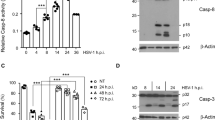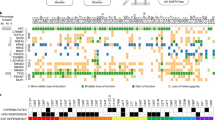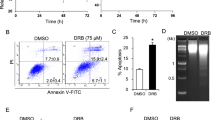Abstract
We previously reported that exposure of DiFi human colon cancer cells to the anti-epidermal growth factor (EGF) receptor monoclonal antibody (mAb) 225 resulted in apoptosis, but the mechanisms remain to be elucidated. In the present study, we investigated the effects of a panel of four anti-EGF receptor mAbs, each of which binds to different epitopes of the EGF receptor in DiFi cells, on the induction of apoptosis. We found that each of these mAbs induced apoptosis in DiFi cells. Exposure of DiFi cells to mAb 225 activated the initiation caspase-8, which was detectable between 8 and 16 h after exposure of the cells to the antibody. There was also an activation of the initiation caspase-9, which lagged a few hours behind the activation of caspase-8. Exposure of DiFi cells to mAb 225 also activated the execution caspase-3, which was accompanied temporally by evidence of cleavage of a well-characterized caspase-3 substrate, poly(ADP)-ribosepolymerase (PARP). Pre-exposure of the cells to the caspase-3-specific inhibitor DEVD-CHO partially reduced the mAb 225-induced PARP cleavage and apoptosis, whereas pre-exposure of the cells to the caspase pan-inhibitor z-VAD-fmk completely inhibited mAb 225-induced apoptosis. Caspases-3, -8 and -9 were not activated in the cell lines in which mAb 225 only induced G1 phase arrest of the cell cycle. In contrast to the apoptosis of DiFi cells induced by ultraviolet irradiation, which strongly activated the c- jun N-terminal kinase-1 (JNK1) and the caspase cascade, mAb 225-induced apoptosis and activation of the caspase cascade in DiFi cells were not associated with activation of JNK1. © 2000 Cancer Research Campaign
Similar content being viewed by others
Article PDF
Change history
16 November 2011
This paper was modified 12 months after initial publication to switch to Creative Commons licence terms, as noted at publication
References
Adachi S, Cross AR, Babior BM and Gottlieb RA (1997) Bcl-2 and the outer mitochondrial membrane in the inactivation of cytochrome c during Fas-mediated apoptosis. J Biol Chem 272: 21878–21882
Ashkenazi A and Dixit VM (1998) Death receptors: signaling and modulation. Science 281: 1305–1308
Baselga J, Mendelsohn J, Kim YM and Pandiella A (1996) Autocrine regulation of membrane transforming growth factor-alpha cleavage. J Biol Chem 271: 3279–3284
Baselga J, Pfister D, Cooper MR, Cohen R, Burtness B, Bos M, D’Andrea G, Seidman A, Norton L, Gunnett K, Falcey J, Anderson V, Waksal H and Mendelsohn J (2000) Phase I studies of anti-epidermal growth factor receptor chimeric antibody C225 alone and in combination with cisplatin. J Clin Oncol In press
Boldin MP, Goncharov TM, Goltsev YV and Wallach D (1996) Involvement of MACH, a novel MORT1/FADD-interacting protease, in Fas/APO-1- and TNF receptor-induced cell death. Cell 85: 803–815
Bossy-Wetzel E, Newmeyer DD and Green DR (1998) Mitochondrial cytochrome c release in apoptosis occurs upstream of DEVD-specific caspase activation and independently of mitochondrial transmembrane depolarization. EMBO J 17: 37–49
Bump NJ, Hackett M, Hugunin M, Seshagiri S, Brady K, Chen P, Ferenz C, Franklin S, Ghayur T and Li P (1995) Inhibition of ICE family proteases by baculovirus antiapoptotic protein p35. Science 269: 1885–1888
Chen YR, Wang X, Templeton D, Davis RJ and Tan TH (1996) The role of c-Jun N-terminal kinase (JNK) in apoptosis induced by ultraviolet C and gamma radiation. Duration of JNK activation may determine cell death and proliferation. J Biol Chem 271: 31929–31936
Chou JL, Fan Z, DeBlasio T, Koff A, Rosen N and Mendelsohn J (1999) Constitutive overexpression of cyclin D1 in human breast epithelial cells does not prevent G1 arrest induced by deprivation of epidermal growth factor. Breast Cancer Res Treat 55: 267–283
Cohen GM (1997) Caspases: the executioners of apoptosis. Biochem J 326 (Pt 1): 1–16
Cowley GP, Smith JA and Gusterson BA (1986) Increased EGF receptors on human squamous carcinoma cell lines. Br J Cancer 53: 223–229
Ellis HM and Horvitz HR (1986) Genetic control of programmed cell death in the nematode. C. elegans. Cell 44: 817–829
Ennis BW, Valverius EM, Bates SE, Lippman ME, Bellot F, Kris R, Schlessinger J, Masui H, Goldenberg A, Mendelsohn J and Dickson RB (1989) Anti-epidermal growth factor receptor antibodies inhibit the autocrine-stimulated growth of MDA-468 human breast cancer cells. Mol Endocrinol 3: 1830–1838
Fan Z and Mendelsohn J (1998) Therapeutic application of anti-growth factor receptor antibodies. Curr Opin Oncol 10: 67–73
Fan Z, Baselga J, Masui H and Mendelsohn J 1993 a) Antitumour effect of anti-epidermal growth factor receptor monoclonal antibodies plus cis-diamminedichloroplatinum on well established A431 cell xenografts. Cancer Res 53: 4637–4642
Fan Z, Masui H, Altas I and Mendelsohn J (1993b) Blockade of epidermal growth factor receptor function by bivalent and monovalent fragments of 225 anti-epidermal growth factor receptor monoclonal antibodies. Cancer Res 53: 4322–4328
Fan Z, Mendelsohn J, Masui H and Kumar R (1993c) Regulation of epidermal growth factor receptor in NIH3T3/HER14 cells by antireceptor monoclonal antibodies. J Biol Chem 268: 21073–21079
Fan Z, Lu Y, Wu X and Mendelsohn J (1994) Antibody-induced epidermal growth factor receptor dimerization mediates inhibition of autocrine proliferation of A431 squamous carcinoma cells. J Biol Chem 269: 27595–27602
Fan Z, Shang BY, Lu Y, Chou JL and Mendelsohn J (1997) Reciprocal changes in p27Kip1 and p21Cip1 in growth inhibition mediated by blockade or overstimulation of epidermal growth factor receptors. Clin Cancer Res 3: 1943–1948
Gill GN, Kawamoto T, Cochet C, Le A, Sato JD, Masui H, McLeod C and Mendelsohn J (1984) Monoclonal anti-epidermal growth factor receptor antibodies which are inhibitors of epidermal growth factor binding and antagonists of epidermal growth factor binding and antagonists of epidermal growth factor-stimulated tyrosine protein kinase activity. J Biol Chem 259: 7755–7760
Green DR (1998) Apoptotic pathways: the roads to ruin. Cell 94: 695–698
Green DR and Reed JC (1998) Mitochondria and apoptosis. Science 281: 1309–1312
Gross ME, Zorbas MA, Danels YJ, Garcia R, Gallick GE, Olive M, Brattain MG, Boman BM and Yeoman LC (1991) Cellular growth response to epidermal growth factor in colon carcinoma cells with an amplified epidermal growth factor receptor derived from a familial adenomatous polyposis patient. Cancer Res 51: 1452–1459
Hendler FJ and Ozanne BW (1984) Human squamous cell lung cancers express increased epidermal growth factor receptors. J Clin Invest 74: 647–651
Hofer DR, Sherwood ER, Bromberg WD, Mendelsohn J, Lee C and Kozlowski JM (1991) Autonomous growth of androgen-independent human prostatic carcinoma cells: role of transforming growth factor alpha. Cancer Res 51: 2780–2785
Ishitoya J, Toriyama M, Oguchi N, Kitamura K, Ohshima M, Asano K and Yamamoto T (1989) Gene amplification and overexpression of EGF receptor in squamous cell carcinomas of the head and neck. Br J Cancer 59: 559–562
Itoh N, Yonehara S, Ishii A, Yonehara M, Mizushima S, Sameshima M, Hase A, Seto Y and Nagata S (1991) The polypeptide encoded by the cDNA for human cell surface antigen Fas can mediate apoptosis. Cell 66: 233–243
Janicke RU, Sprengart ML, Wati MR and Porter AG 1998 a) Caspase-3 is required for DNA fragmentation and morphological changes associated with apoptosis. J Biol Chem 273: 9357–9360
Janicke RU, Ng P, Sprengart ML and Porter AG 1998 b) Caspase-3 is required for alpha-fodrin cleavage but dispensable for cleavage of other death substrates in apoptosis. J Biol Chem 273: 15540–15545
Karnes WJ, Walsh JH, Wu SV, Kim RS, Martin MG, Wong HC, Mendelsohn J, Park JG and Cuttitta F (1992) Autonomous proliferation of colon cancer cells that coexpress transforming growth factor alpha and its receptor. Variable effects of receptor-blocking antibody. Gastroenterology 102: 474–485
Kharbanda S, Pandey P, Schofield L, Israels S, Roncinske R, Yoshida K, Bharti A, Yuan ZM, Saxena S, Weichselbaum R, Nalin C and Kufe D (1997) Role for Bcl-xL as an inhibitor of cytosolic cytochrome C accumulation in DNA damage-induced apoptosis. Proc Natl Acad Sci U S A 94: 6939–6942
Kim CN, Wang X, Huang Y, Ibrado AM, Liu L, Fang G and Bhalla K (1997) Overexpression of Bcl-X(L) inhibits Ara-C-induced mitochondrial loss of cytochrome c and other perturbations that activate the molecular cascade of apoptosis. Cancer Res 57: 3115–3120
Kluck RM, Bossy-Wetzel E, Green DR and Newmeyer DD (1997) The release of cytochrome c from mitochondria: a primary site for Bcl-2 regulation of apoptosis. Science 275: 1132–1136
Lee M, Draoui M, Zia F, Gazdar A, Oie H, Bepler G, Bellot F, Tarr C, Kris R and Moody TW (1992) Epidermal growth factor receptor monoclonal antibodies inhibit the growth of lung cancer cell lines. J Natl Cancer Inst Monogr 13: 117–123
Lei W, Yu R, Mandlekar S and Kong AN (1998) Induction of apoptosis and activation of interleukin 1beta-converting enzyme/Ced-3 protease (caspase-3) and c-Jun NH2-terminal kinase 1 by benzo(a)pyrene. Cancer Res 58: 2102–2106
Li H, Zhu H, Xu CJ and Yuan J (1998) Cleavage of BID by caspase 8 mediates the mitochondrial damage in the Fas pathway of apoptosis. Cell 94: 491–501
Masui H, Boman BM, Hyman J, Castro L and Mendelsohn J (1991) Treatment with anti-EGF receptor monoclonal antibody causes regression of DiFi human colorectal carcinoma xenografts. Proc Am Assoc Cancer Res 32: 394
Mendelsohn J, Shin DM, Donato N, Khuri F, Radinsky R, Glisson BS, Shin HJ, Metz E, Pfister D, Perez-Soler R, Lawhorn K, Matsumoto T, Gunnett K, Falcey J, Waksal H and Hong WK (1999) A phase I study of chimerized anti-epidermal growth factor receptor (EGFR) monoclonal antibody, C225, in combination with cisplatin (CDDP) in patients (pts) with recurrent head and neck squamous cell carcinoma (SCC). Proc Am Soc Clin Oncol 18: 389a
Modjtahedi H, Eccles S, Box G, Styles J and Dean C (1993) Immunotherapy of human tumour xenografts overexpressing the EGF receptor with rat antibodies that block growth factor-receptor interaction. Br J Cancer 67: 254–261
Muhlenbeck F, Haas E, Schwenzer R, Schubert G, Grell M, Smith C, Scheurich P and Wajant H (1998) TRAIL/Apo2L activates c-Jun NH2-terminal kinase (JNK) via caspase-dependent and caspase-independent pathways. J Biol Chem 273: 33091–33098
Muzio M, Chinnaiyan AM, Kischkel FC, O’Rourke K, Shevchenko A, Ni J, Scaffidi C, Bretz JD, Zhang M, Gentz R, Mann M, Krammer PH, Peter ME and Dixit VM (1996) FLICE, a novel FADD-homologous ICE/CED-3-like protease, is recruited to the CD95 (Fas/APO-1) death-inducing signaling complex. Cell 85: 817–827
Muzio M, Stockwell BR, Stennicke HR, Salvesen GS and Dixit VM (1998) An induced proximity model for caspase-8 activation. J Biol Chem 273: 2926–2930
Neal DE, Marsh C, Bennett MK, Abel PD, Hall RR, Sainsbury JR and Harris AL (1985) Epidermal-growth-factor receptors in human bladder cancer: comparison of invasive and superficial tumours. Lancet 1: 366–368
Ozanne B, Richards CS, Hendler F, Burns D and Gusterson B (1986) Over-expression of the EGF receptor is a hallmark of squamous cell carcinomas. J Pathol 149: 9–14
Peng D, Fan Z, Lu Y, DeBlasio T, Scher H and Mendelsohn J (1996) Anti-epidermal growth factor receptor monoclonal antibody 225 up-regulates p27KIP1 and induces G1 arrest in prostatic cancer cell line DU145. Cancer Res 56: 3666–3669
Perez-Soler R, Shin D, Donato N, Radinsky R, Khuri F, Glisson BS, Shin H, Matsumoto T, Lawhorn K, Hong WK and Mendelsohn J (1998) Tumour studies in patients with head and neck cancer treated with humanized anti-epidermal growth factor receptor (EGFR) monoclonal antibody C225 in combination with cisplatin. Proc Am Soc Clin Oncol 17: 393a
Perrotte P, Matsumoto T, Inoue K, Kuniyasu H, Eve BY, Hicklin DJ, Radinsky R and Dinney CP (1999) Anti-epidermal growth factor receptor antibody C225 inhibits angiogenesis in human transitional cell carcinoma growing orthotopically in nude mice. Clin Cancer Res 5: 257–265
Prewett M, Rothman M, Waksal H, Feldman M, Bander NH and Hicklin DJ (1998) Mouse-human chimeric anti-epidermal growth factor receptor antibody C225 inhibits the growth of human renal cell carcinoma xenografts in nude mice. Clin Cancer Res 4: 2957–2966
Sainsbury JR, Malcolm AJ, Appleton DR, Farndon JR and Harris AL (1985) Presence of epidermal growth factor receptor as an indicator of poor prognosis in patients with breast cancer. J Clin Pathol 38: 1225–1228
Sato JD, Kawamoto T, Le AD, Mendelsohn J, Polikoff J and Sato GH (1983) Biological effects in vitro of monoclonal antibodies to human epidermal growth factor receptors. Mol Biol Med 1: 511–529
Schmidt M, Vakalopoulou E, Schneider DW and Wels W (1997) Construction and functional characterization of scFv(14E1)-ETA – a novel, highly potent antibody-toxin specific for the EGF receptor. Br J Cancer 75: 1575–1584
Seimiya H, Mashima T, Toho M and Tsuruo T (1997) c-Jun NH2-terminal kinase-mediated activation of interleukin-1β converting enzyme/CED-3-like protease during anticancer drug-induced apoptosis. J Biol Chem 272: 4631–4636
Shiah SG, Chuang SE, Chau YP, Shen SC and Kuo ML (1999) Activation of c-Jun NH2-terminal kinase and subsequent CPP32/Yama during topoisomerase inhibitor β-lapachone-induced apoptosis through an oxidation-dependent pathway. Cancer Res 59: 391–398
Stampfer MR, Pan CH, Hosoda J, Bartholomew J, Mendelsohn J and Yaswen P (1993) Blockage of EGF receptor signal transduction causes reversible arrest of normal and immortal human mammary epithelial cells with synchronous reentry into the cell cycle. Exp Cell Res 208: 175–188
Sun XM, MacFarlane M, Zhuang J, Wolf BB, Green DR and Cohen GM (1999) Distinct caspase cascades are initiated in receptor-mediated and chemical-induced apoptosis. J Biol Chem 274: 5053–5060
Susin SA, Lorenzo HK, Zamzami N, Marzo I, Snow BE, Brothers GM, Mangion J, Jacotot E, Costantini P, Loeffler M, Larochette N, Goodlett DR, Aebersold R, Siderovski DP, Penninger JM and Kroemer G (1999) Molecular characterization of mitochondrial apoptosis-inducing factor. Nature 397: 441–446
Tewari M, Quan LT, O’Rourke K, Desnoyers S, Zeng Z, Beidler DR, Poirier GG, Salvesen GS and Dixit VM (1995) Yama/CPP32 beta, a mammalian homolog of CED-3, is a CrmA-inhibitable protease that cleaves the death substrate poly(ADP-ribose) polymerase. Cell 81: 801–809
Thornberry NA and Lazebnik Y (1998) Caspases: enemies within. Science 281: 1312–1316
Ullrich A and Schlessinger J (1990) Signal transduction by receptors with tyrosine kinase activity. Cell 61: 203–212
Untawale S, Zorbas MA, Hodgson CP, Coffey RJ, Gallick GE, North SM, Wildrick DM, Olive M, Blick M, Yeoman LC and Boman BM (1993) Transforming growth factor-alpha production and autoinduction in a colorectal carcinoma cell line (DiFi) with an amplified epidermal growth factor receptor gene. Cancer Res 53: 1630–1636
Van de Vijver MJ, Kumar R and Mendelsohn J (1991) Ligand-induced activation of A431 cell epidermal growth factor receptors occurs primarily by an autocrine pathway that acts upon receptors on the surface rather than intracellularly. J Biol Chem 266: 7503–7508
Veale D, Ashcroft T, Marsh C, Gibson GJ and Harris AL (1987) Epidermal growth factor receptors in non-small cell lung cancer. Br J Cancer 55: 513–516
Wersall P, Ohlsson I, Biberfeld P, Collins VP, von Krusenstjerna S, Larsson S, Mellstedt H and Boethius J (1997) Intratumoural infusion of the monoclonal antibody, mAb 425, against the epidermal-growth-factor receptor in patients with advanced malignant glioma. Cancer Immunol Immunother 44: 157–164
Woo M, Hakem R, Soengas MS, Duncan GS, Shahinian A, Kagi D, Hakem A, McCurrach M, Khoo W, Kaufman SA, Senaldi G, Howard T, Lowe SW and Mak TW (1998) Essential contribution of caspase 3/CPP32 to apoptosis and its associated nuclear changes. Genes Dev 12: 806–819
Wu X, Fan Z, Masui H, Rosen N and Mendelsohn J (1995) Apoptosis induced by an anti-epidermal growth factor receptor monoclonal antibody in a human colorectal carcinoma cell line and its delay by insulin. J Clin Invest 95: 1897–1905
Wu X, Rubin M, Fan Z, DeBlasio T, Soos T, Koff A and Mendelsohn J (1996) Involvement of p27KIP1 in G1 arrest mediated by an anti-epidermal growth factor receptor monoclonal antibody. Oncogene 12: 1397–1403
Xiang J, Chao DT and Korsmeyer SJ (1996) BAX-induced cell death may not require interleukin 1β-converting enzyme-like proteases. Proc Natl Acad Sci U S A 93: 14559–14563
Yang X, Chang HY and Baltimore D (1998) Autoproteolytic activation of pro-caspases by oligomerization. Mol Cell 1: 319–325
Ye D, Mendelsohn J and Fan Z (1999) Augmentation of a humanized anti-HER2 mAb 4D5 induced growth inhibition by a human-mouse chimeric anti-EGF receptor mAb C225. Oncogene 18: 731–738
Author information
Authors and Affiliations
Rights and permissions
From twelve months after its original publication, this work is licensed under the Creative Commons Attribution-NonCommercial-Share Alike 3.0 Unported License. To view a copy of this license, visit http://creativecommons.org/licenses/by-nc-sa/3.0/
About this article
Cite this article
Liu, B., Fang, M., Schmidt, M. et al. Induction of apoptosis and activation of the caspase cascade by anti-EGF receptor monoclonal antibodies in DiFi human colon cancer cells do not involve the c- jun N-terminal kinase activity. Br J Cancer 82, 1991–1999 (2000). https://doi.org/10.1054/bjoc.2000.1201
Received:
Revised:
Accepted:
Published:
Issue date:
DOI: https://doi.org/10.1054/bjoc.2000.1201
Keywords
This article is cited by
-
Excess reactive oxygen species production mediates monoclonal antibody-induced human embryonic stem cell death via oncosis
Cell Death & Differentiation (2017)
-
Immuntherapie von Kopf-Hals-Karzinomen
HNO (2011)
-
Understanding resistance to EGFR inhibitors—impact on future treatment strategies
Nature Reviews Clinical Oncology (2010)
-
PUMA mediates EGFR tyrosine kinase inhibitor-induced apoptosis in head and neck cancer cells
Oncogene (2009)
-
Responses of cancer cells with wild-type or tyrosine kinase domain-mutated epidermal growth factor receptor (EGFR) to EGFR-targeted therapy are linked to downregulation of hypoxia-inducible factor-1α
Molecular Cancer (2007)



